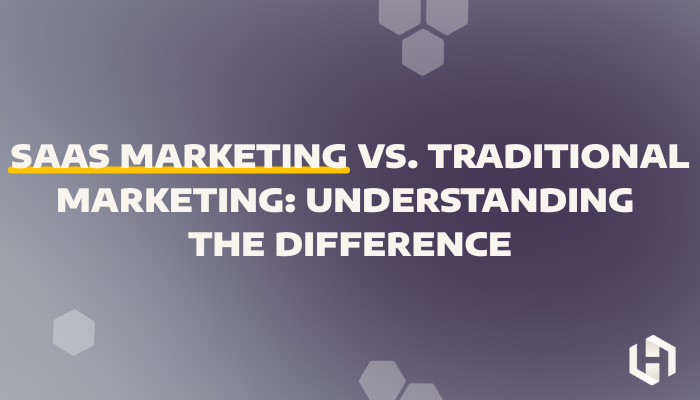Marketing strategies are always evolving—this is no secret. But the gap between SaaS marketing and traditional marketing is bigger than the gap between the New Orleans Saints and the Kansas City Chiefs in a lopsided playoff game. While both aim to attract, convert, and retain customers, their approaches differ significantly due to the nature of their business models. Let’s break down these differences and explore how SaaS companies are innovating to stay ahead.
Table of Contents
- The Subscription Model: Retention is Key
- AI and Personalization: Elevating the Customer Experience
- Account-Based Marketing (ABM): Precision Over Reach
- Content Marketing: Building Authority and Trust
- Customer Success as a Marketing Strategy
- Data-Driven Decision-Making
- Visual Storytelling: Making Complex Concepts Digestible
- Why These Differences Matter
The Subscription Model: Retention is Key
Traditional marketing often prioritizes customer acquisition, focusing heavily on driving one-time purchases or short-term gains. For SaaS companies, the game changes completely. With subscription-based revenue models, retaining customers becomes just as important as acquiring them. Strategies like personalized customer experiences, proactive support, and constant value delivery are super important when it comes to reducing churn and boosting lifetime value.
For example, a SaaS tool like Slack doesn’t just aim to sell its software once. Its marketing efforts highlight ongoing updates, integrations, and value-added features that keep teams engaged and subscribing month after month. Think of it as the difference between convincing someone to buy a fancy coffee maker versus ensuring they keep coming back for your gourmet coffee pods.
AI and Personalization: Elevating the Customer Experience
Artificial intelligence (AI) is reshaping marketing across industries, but SaaS companies are leading the charge. From predictive analytics to hyper-personalized content delivery, AI allows SaaS marketers to understand customer needs on a granular level and deliver tailored experiences.
For instance, AI can identify when a user struggles with certain software features and trigger support resources or suggest upgrades at the perfect time—almost like a friend who knows exactly when you need a pep talk. Traditional marketing, with its broader and less dynamic approach, often misses this opportunity to connect on such a personalized level.
Account-Based Marketing (ABM): Precision Over Reach
In traditional marketing, broad-reach campaigns—billboards, print ads, and mass media—are common. SaaS companies, however, are increasingly adopting Account-Based Marketing (ABM) to target high-value accounts with tailored campaigns. ABM focuses on building relationships with decision-makers and delivering solutions to their specific pain points, creating a long-term partnership rather than a one-off transaction.
A B2B SaaS company offering CRM solutions might run campaigns targeting sales executives at mid-market enterprises. It’s like spearfishing instead of casting a wide net—a precise, targeted approach that ensures the catch is worth the effort.
Content Marketing: Building Authority and Trust
Content marketing is essential for SaaS brands. By offering whitepapers, e-books, webinars, and blog posts, they position themselves as thought leaders while nurturing leads through the sales funnel. Traditional marketing often focuses on product-centric messaging, but SaaS marketers create value by educating their audience and solving their problems.
Here's a hot tip: SaaS buyers expect answers faster than they can Google them. This is how well-optimized, high-value content can make you the go-to source for solutions, building trust and authority in your space. Content marketing has always been king among many industries but could not be more important when it comes to SaaS marketing.
Customer Success as a Marketing Strategy
Customer success isn’t just a retention tool for SaaS companies; it’s a marketing powerhouse. Happy customers become brand advocates, sharing their positive experiences with peers and across the internet. Building robust customer success teams that proactively address customer needs can transform users into loyal promoters. Traditional marketing rarely integrates this level of post-purchase engagement into its strategy.
Foe example, a project management SaaS company could feature customer stories or host user-generated webinars to showcase how its tools help teams achieve tangible results. Think of these advocates as free marketing interns—but with way less coaching and way more weight when it comes to spreading your praises.
Data-Driven Decision-Making
If there's one industry that absolutely cannot survive without constantly analyzing data, it's the SaaS industry. SaaS marketers absolutely thrive on data. Subscription models generate a wealth of user behavior data, allowing companies to refine their strategies– and they do, continuously. From A/B testing email campaigns to analyzing product usage, SaaS marketers rely on real-time insights to improve outcomes. Traditional marketing typically leans on historical data and broad demographic trends, offering fewer opportunities for immediate course correction. If SaaS marketers could analyze their coffee intake to boost retention, they’d probably do that too.
Visual Storytelling: Making Complex Concepts Digestible
SaaS marketing often tackles technical or abstract concepts, requiring clear and engaging communication. Visuals—infographics, demo videos, or explainer animations—play a crucial role in simplifying the message. Adding updated visuals to your campaigns or blogs can boost engagement and comprehension. After all, a picture is worth a thousand lines of code.
Why These Differences Matter
Understanding the unique challenges and opportunities in SaaS marketing helps marketers create more effective strategies. Traditional tactics don’t translate directly to the SaaS world. Success comes from embracing innovation, leveraging data, and putting the customer at the center of every decision.
As the SaaS industry continues to grow—projected to reach $819.23 billion by 2030—marketers must evolve with it. Whether through ABM campaigns, AI-driven insights, or a renewed focus on retention, the future of SaaS marketing is about staying agile and customer-focused. If you're looking for a partner to help you refine your SaaS marketing strategy, let's chat about what success we can achieve together!




.png?width=100&height=100&name=Why%20Were%20Not%20a%20Marketing%20Agency%20(And%20What%20That%20Means%20for%20Your%20Growth).png)
